Han anyone else thought about building a La Scala type enclosure with different dimensions? I have a Joseph Crowe ES600 horn equipped with a SB Audience 65CDN-T compression driver and was planning to build a La Scala type bin but feel the ES600 would out of place with the 24.5 inch (62cm) wide box. So I thought I could maybe build a narrower and taller box keeping the same area for the throat an mouth. What do you think? Stupid idea? 🙂

At first I thought: Why Not? But on second thought, would it not change the dispersion pattern? Less of an issue at the lower frequencies, but in the Mid's, and in particular, around the cross-over frequency. Disclaimer: I have zero experience in this sort of thing, just thinking off the top of my head!
and a further thought: maybe rotate the guts of the horn by 90 degrees? That would stiffen the long side walls, but again, what would that do for the radiation pattern?
and a further thought: maybe rotate the guts of the horn by 90 degrees? That would stiffen the long side walls, but again, what would that do for the radiation pattern?
Well I'm was planning to to crossover at 600Hz since that's the lower limit of the horn I have.. The wavelength at 600Hz is about 57 centimeters (23") so a 90 cm high horn might be emitting those frequencies close to the floor, a long way from the ES600 horn causing some problems. It would probably be pretty hard to fit the 15" woofer into the doghouse without getting into problems with space at the back and sides. Maybe I can make it a little bit slimmer and taller. Next stop Hornresp!
The wanted look or aesthetic is understood.
The thought of stacking the design has crossed my mind.
Not to make it narrow, for same size horn.
Stacking to make a larger horn for lower frequency response.
Of course the classic corner loaded horn using walls to extend the horn and response
is a well covered idea as well.
The rendering you show, looks very nice though. Sounds good to me.
I do like the look of matching sizes.
Then again Really big ugly bass bins way bigger than the mid/ high horns dont bother me either.
I do like the classy matching look you came up with regardless.
Little more realistic and visually pleasing for home use indeed.
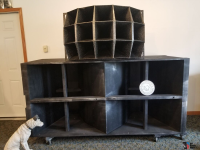
The thought of stacking the design has crossed my mind.
Not to make it narrow, for same size horn.
Stacking to make a larger horn for lower frequency response.
Of course the classic corner loaded horn using walls to extend the horn and response
is a well covered idea as well.
The rendering you show, looks very nice though. Sounds good to me.
I do like the look of matching sizes.
Then again Really big ugly bass bins way bigger than the mid/ high horns dont bother me either.
I do like the classy matching look you came up with regardless.
Little more realistic and visually pleasing for home use indeed.

I don't see any sonic reason to have the woofer box the same width as the CD horn. The - 3 db width should be the same, but this has to with horn design, not horn exit width.
Taking the CD down to 600 hz will limit wattage to that suitable for one listener in a quiet room. With 70 w CD RX22, 1985 Peavey SP2 had pink noise wattage at 175. Crossover was 800 hz. 1995 SP2 with 1200 hz crossover was rated 300 w. 2004 SP2 with 1800 hz crossover is 500 w. The latter requires a pinched back reflex box to get 6 db point out to +- 45 deg horizontal at 1800 hz.
Doesn't a bass reflected horn design mess up the impulse response of bass drums, for example? I was not impressed with Klipschhorn in 1976, but the trumpet+stringbass+drumkit jazz they were demonstrating with was not much of a test.
Taking the CD down to 600 hz will limit wattage to that suitable for one listener in a quiet room. With 70 w CD RX22, 1985 Peavey SP2 had pink noise wattage at 175. Crossover was 800 hz. 1995 SP2 with 1200 hz crossover was rated 300 w. 2004 SP2 with 1800 hz crossover is 500 w. The latter requires a pinched back reflex box to get 6 db point out to +- 45 deg horizontal at 1800 hz.
Doesn't a bass reflected horn design mess up the impulse response of bass drums, for example? I was not impressed with Klipschhorn in 1976, but the trumpet+stringbass+drumkit jazz they were demonstrating with was not much of a test.
My comment would be about how beautiful the first photo was. Beyond the striking looks, I could only hope that it would be possible to make the acoustics work. I do wonder at the idea of the 600hz crossover though.
Yes, the width ís only about looks. I was just wondering if I change the height-width ratio but keep horn length, throat and mouth sizes. I think it would still look good.a little wider (and lower). Would it work the same.
The most obvious solution for my project would be an EV Eliminator bin since that would “eliminate” guesswork for my EVM 15B woofers. Maybe I can make it look nice with some good wood veneer and careful carpentry. …unless I feel the need to redesign the wheel. 😂
The most obvious solution for my project would be an EV Eliminator bin since that would “eliminate” guesswork for my EVM 15B woofers. Maybe I can make it look nice with some good wood veneer and careful carpentry. …unless I feel the need to redesign the wheel. 😂
I like the look of post #1. I first bought speakers at the end of the age of real walnut veneer, (KLH23) and don't like the black on black with plastic horn of my excellent sounding Peavey SP2(2004). I have bought a CD, horn, and woofer for a replacement. Your picture makes me think of sending my aluminum eminence horns out for a bronze anodize treatment.
The church I donated the KLH23's to hated the walnut look so much that they put them away for Mackie Thumpers. 6" woofer black active trash mounted all over the stage back instead of in front of the performers. The 23's were 10" woofers driven by 100 class AB watts. PA behind the musicians, feedback city unless every musician plays electric guitar or toy keyboard. The ruling elder hated bass anyway.
The church I donated the KLH23's to hated the walnut look so much that they put them away for Mackie Thumpers. 6" woofer black active trash mounted all over the stage back instead of in front of the performers. The 23's were 10" woofers driven by 100 class AB watts. PA behind the musicians, feedback city unless every musician plays electric guitar or toy keyboard. The ruling elder hated bass anyway.
If you go for the same design principle of a single folded horn with a single 15" driver you would end up with a first section with a larger flare constant and the second section with a lower flare constant than the original horn. Therefore my suggestion for 2x12" instead of 1x15". You would have to model what you intend to do in order to be on the safe side.Yes, the width ís only about looks. I was just wondering if I change the height-width ratio but keep horn length, throat and mouth sizes. I think it would still look good.a little wider (and lower). Would it work the same.
Regards
Charles
The EV Eliminator is a nice design for Disco music and the like, even outdoors. Anyway, with it's f3 near to 70Hz you will miss the low end .
How I know? I still got a pair of them in my party room. Build them from original plans with the EVM 15B and some reinforcements, about 40 years ago.
Sometimes I'm thinking about a combination with two 18" ripole subwoofers.
The lower you cross them over, the better. We did 800 Hz for PA, this seems very high nowadays.
I don't think I would build them like that today.
They do not reach deep enough without a sub and not high enough for a high quality promising crossing to a CD. So you start to think about a sub and a 10" or 12" in a front loaded horn to make it full range. Which may make sense in a large PA system nobody wants today.
How I know? I still got a pair of them in my party room. Build them from original plans with the EVM 15B and some reinforcements, about 40 years ago.
Sometimes I'm thinking about a combination with two 18" ripole subwoofers.
The lower you cross them over, the better. We did 800 Hz for PA, this seems very high nowadays.
I don't think I would build them like that today.
They do not reach deep enough without a sub and not high enough for a high quality promising crossing to a CD. So you start to think about a sub and a 10" or 12" in a front loaded horn to make it full range. Which may make sense in a large PA system nobody wants today.
Definitely, which would be interesting. I have never seen a Wood Veneer 1AThe most obvious solution for my project would be an EV Eliminator bin since that would “eliminate” guesswork for my EVM 15B woofers. Maybe I can make it look nice with some good wood veneer and careful carpentry. …unless I feel the need to redesign the wheel. 😂
I have seen Tolex / Vinyl versions from numerous Musical instrument companies but never pretty wood.
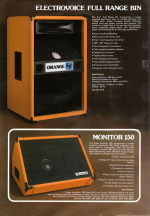
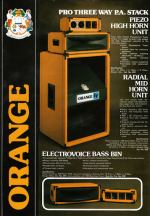
I have seen JBL 4530's with wood finish.
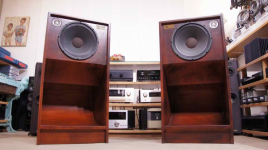
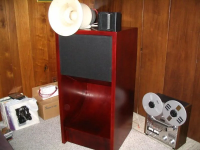
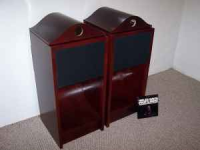
a few thoughts: if you made the cabinet thinner, you'd have to change the woofer size. With a 12" woofer, that roughly equates to a 20" reduction, or about 18" or 46cm inner width. if you made it taller and maintained the doghouse volume, it should not negatively affect the transfer function much down low, where the speaker stops working as a horn and begins to work as a direct radiator; since the horn length is 20% shorter, it will likely raise it slightly, from around 110Hz to 120Hz. it may also not extend as low, raising the low end drop off from 55Hz, but this will depend on the T/S parameters of the driver you select; it's more difficult to source a 12" driver for horn loading and bass response than a 15" driver. I'm not sure about the upper transfer function, the OEM LS runs out of steam around 500Hz, which is related both to the horn design and driver selection. It may or may not work to cross at 600Hz.Han anyone else thought about building a La Scala type enclosure with different dimensions? I have a Joseph Crowe ES600 horn equipped with a SB Audience 65CDN-T compression driver and was planning to build a La Scala type bin but feel the ES600 would out of place with the 24.5 inch (62cm) wide box. So I thought I could maybe build a narrower and taller box keeping the same area for the throat an mouth. What do you think? Stupid idea? 🙂
View attachment 1453186
one thing to consider for using the original dimensions is that baffle effect can have a positive impact on the mid horn's frequency and phase response- setting it in a 24" wide baffle may be better than leaving the horn naked, as in your illustration.
20% reduction in size, not 20"...a few thoughts: if you made the cabinet thinner, you'd have to change the woofer size. With a 12" woofer, that roughly equates to a 20% reduction, or about 18" or 46cm inner width. if you made it taller and maintained the doghouse volume, it should not negatively affect the transfer function much down low, where the speaker stops working as a horn and begins to work as a direct radiator; since the horn length is 20% shorter, it will likely raise it slightly, from around 110Hz to 120Hz. it may also not extend as low, raising the low end drop off from 55Hz, but this will depend on the T/S parameters of the driver you select; it's more difficult to source a 12" driver for horn loading and bass response than a 15" driver. I'm not sure about the upper transfer function, the OEM LS runs out of steam around 500Hz, which is related both to the horn design and driver selection. It may or may not work to cross at 600Hz.
one thing to consider for using the original dimensions is that baffle effect can have a positive impact on the mid horn's frequency and phase response- setting it in a 24" wide baffle may be better than leaving the horn naked, as in your illustration.
- Home
- Loudspeakers
- Multi-Way
- A taller DIY La Scala style mid-bass bin